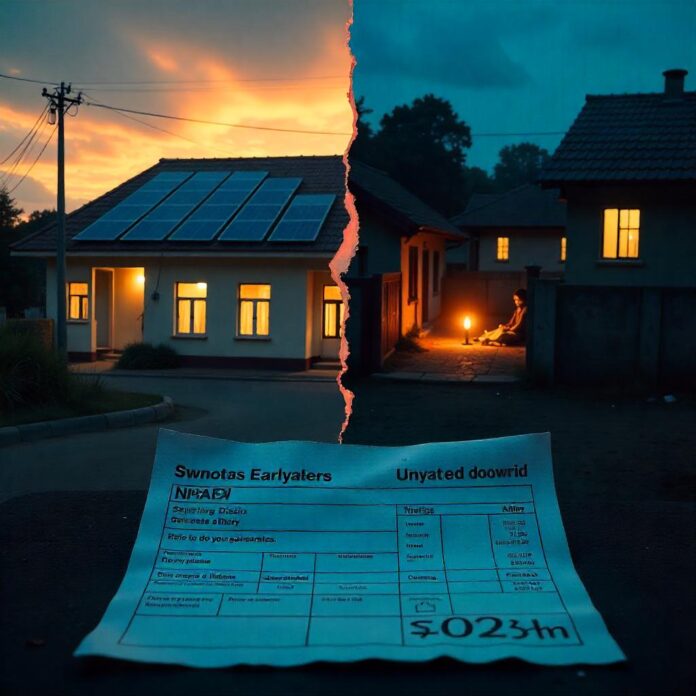Picture this: Nigeria’s Presidential Villa basks in the glow of a ₦10 billion solar mini-grid while 92 million citizens endure daily blackouts. In April 2025, the Federal Executive Council approved this project, ballooning the State House’s capital budget to ₦57 billion—a decision officials call sustainable but critics brand energy apartheid. The optics are jarring: Aso Rock owes ₦923 million in unpaid electricity bills to the Abuja Electricity Distribution Company, yet now invests billions to exit the very grid ordinary Nigerians cannot escape. This isn’t just about solar panels; it’s about a leadership class potentially seceding from Nigeria’s broken energy system while leaving citizens in the dark.
The Project Breakdown: Costs, Claims, and Contradictions
The Solar Blueprint
The off-grid system aims to power presidential residences, offices, and support buildings using high-efficiency photovoltaic panels and battery storage. Its ₦10 billion price tag consumes 21% of the State House’s 2025 capital expenditure—a staggering allocation amid nationwide blackouts and austerity measures. Procurement details remain undisclosed, fueling suspicions of inflated contracts.
Official Justifications
Presidency spokesperson Bayo Onanuga defends the project as global best practice, citing solar installations at the White House and Buckingham Palace. He frames it as a cost-saving measure, noting the Villa’s ₦483 million quarterly electricity bills and mounting debts. Energy Commission Director-General Mustapha Abdullahi adds it will showcase renewable leadership.
The Flawed Precedent Argument
While Western palaces adopted solar for environmental reasons, Nigeria’s push stems from grid collapse. Unlike the U.S. or U.K., Nigeria lacks a national net-metering policy or feed-in tariffs to scale renewables democratically. This turns the global precedent defense into a hollow soundbite.
The Privilege Argument: Why Critics Cry Foul
Leadership Disconnect
Instead of fulfilling his promise to fix power, the President isolates himself from the very system he vowed to fix. This sentiment echoes nationally. While Tinubu pledged 24/7 power within his first year, businesses now spend $29 billion annually on diesel generators, and households ration candles. The Villa’s solar project feels less like innovation and more like symbolic secession.
Comparative Suffering in Numbers
| Indicator | Aso Rock Villa | National Average |
|---|---|---|
| Power Reliability | 24/7 solar guarantee | 2–4 hours daily |
| Energy Spending | ₦10bn for one complex | ₦16tn on generators |
| Debt Accountability | ₦923m owed to AEDC | 86 MDAs owe ₦47.1bn |
| Solar Access | Custom import waivers | Ban on solar panel imports |
Systemic Hypocrisy
A nurse’s viral placard at National Hospital read: No solar here… Aso Rock gets ₦10bn. Tinubu restricts solar panel imports while the Villa plans luxury foreign tech. States like Enugu and Ondo struggle to fund mini-grids for schools, while federal resources flow to elite sanctuaries.
The Priority Perspective: Can Leadership Set an Example?
The Green Governance Case
Proponents argue the project could pioneer decentralized energy models, potentially saving ₦47 billion yearly from MDAs’ generator bills. If sourced locally, it might ignite Nigeria’s solar industry, creating 56,000 jobs per 10 gigawatts deployed.
Parallel Progress or Distraction?
While the Villa solar plan advances, Nigeria’s broader energy strategy shows flickers of hope: Siemens transformers boosting transmission by 700MW, ₦328.8 million transmission lines under construction, and states like Ekiti leveraging the 2023 Electricity Act to build local grids. Yet these lack the Villa’s funding urgency.
The Demonstration Project Dilemma
The Renewable Energy Association of Nigeria warns that without local content rules, the project risks becoming a photovoltaic importation jamboree. Nigeria imports 80% of solar components—a drain on forex reserves the government claims it wants to plug.
The Elite Energy Transition Framework: Symptoms & Solutions
Diagnosing the Divide
Symbolic Secession: Leaders physically disconnecting from public infrastructure. Resource Hijacking: Elite capture of green financing meant for national development. Trust Deficit: Condemnations of the project as an admission of power sector collapse.
Reclaiming the Transition
Model 1: Inclusive Procurement – Mandate competitive bids from local manufacturers. Model 2: Cascading Benefits – Direct the Villa’s energy savings to fund rural mini-grids. Model 3: Transparent Audit – Publish real-time Villa energy usage and cost savings.
The Roadmap: Beyond Panels to Power Justice
Immediate Alternatives
Redirecting ₦10bn could meter 500,000+ homes under the Presidential Metering Initiative, scale Ekiti’s grid-stabilization model nationwide, and absorb the Villa’s ₦923m AEDC debt to prevent service cuts.
Long-Term Structural Shifts
Decentralize Grids: Empower states via the Electricity Act to build local markets. Cross-Subsidize: Tax luxury solar installations to fund public access. Bridge Skills Gaps: Train 5,000 technicians via German-Nigerian partnerships.
A True Leadership Test
When Boko Haram built solar farms in Sambisa, we bombed them. Today, we imitate them.
Light for the Villa or Light for Nigeria?
The Aso Rock solar project crystallizes Nigeria’s energy crossroads: elite insulation versus inclusive transformation. True leadership would use the Villa’s panels not as an escape hatch, but as the first tile in a national mosaic of renewable justice. Until every hospital and home gains reliable power, this elite energy transition remains a gilded betrayal of 200 million Nigerians waiting in the dark.
The sun shines on all—not just palaces.


